Slovenia Continues
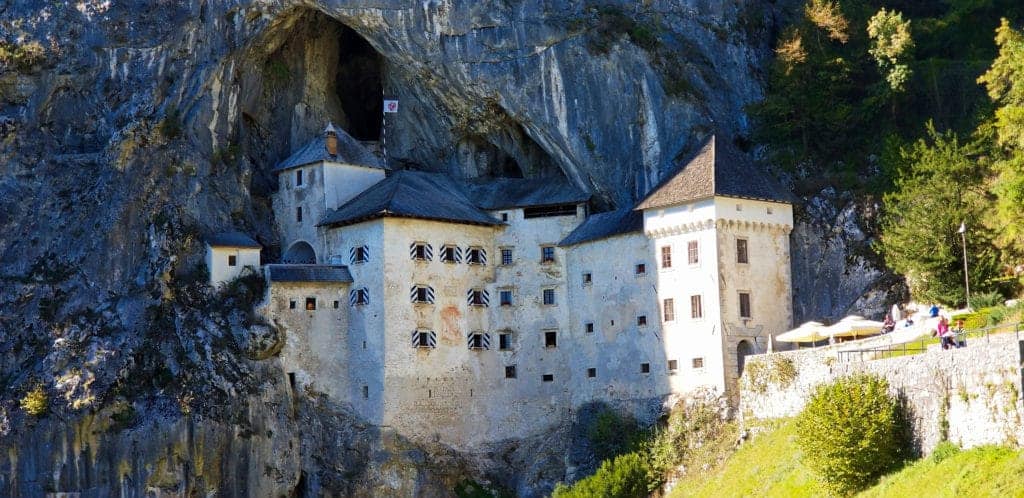
Mike and I left Lake Bled and Triglav National Park heading for three well known tourist sites, Predjama Castle, Postojna Cave and the Lippizan Stallion stud farm. We spent a few days in the area just touring around and talking with people. We met a couple in their late 20s on a walk one day. To this day they are still mad about how much of their land, especially their water frontage, was given to Italy and Croatia. Slovenia has less than 47 km of coastline on the Adriatic Sea, none of which is sandy beaches. As an aside, Croatia has 1,800 km of coastline on the Adriatic and of course Italy has a huge coastline. I tried to look into the history of Slovenia. I did find out that much of Slovenia was given to Italy after WWI but it appears that they got it back when Yugoslavia was formed. I am really not sure what parts of Italy and Croatia this couple felt should belong to Slovenia.
On a completely different topic. I saw a TV show (You Tube actually, it is almost all we watch that isn’t taped) about e-bikes. They were talking about how huge e-bike sales were in China. For Europe 1 in 3 bikes sold in Germany are now e-bikes, 1 in 2 sold in flat Holland are e-bikes but only 1 in 100 in the UK are e-bikes. They blamed the difference on promotion and knowledge. I wonder what the number would be in Canada and the US, a very small percentage I would think. Mike and I would make great promoters of this technology.
As I mentioned previously, the motor on our washer dryer has gone. Hopefully we can replace it when we get home for Christmas but that means a few months without a laundry machine. Laundromats are not very common over here. We have had multiple campers complain about that. You may remember that we have actually done laundry for other campers before now. The town we are currently camped near has a laundromat! Yeah, it was getting desperate. It cost us $36 to do a couple of loads of laundry. We need to get a new motor sooner rather than later.
A Slovenian official followed us into a gas station when we were driving the RV and towing the car. After our $600 fine last week, officials make us more nervous than they used to. It turns out that the gentleman just wanted to take a picture. He said that he had seen us camping in a previous town. When we are towing the car, we have a sign in the back window that says “Be Patient. Pushing a Large Load.” It is meant to be funny and goes over well in North America. This official who, like most people in Europe, has never seen a car towed on the road by a camper. He spoke as though he actually believed our sign. He said that he hadn’t understood earlier why we had a car and a camper but now that he knew we needed the car to PUSH the camper he understood. I felt terrible.
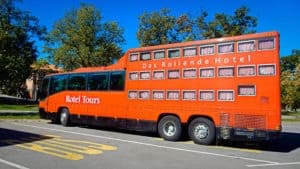
Here is a picture for all our friends with claustrophobia. It is a tour bus called a rotel or rolling hotel. This is the second one we have seen on our trip. Those little windows at the back are each one tiny bedroom. From what I read on the internet, everyone gets one little cubbyhole to sleep in. They are allowed to get at their luggage, which travels separately, once ever three days. You are expected to keep enough for three days in one small bag in your “bedroom”. They advertise getting to go to places that other tour buses can’t get to. I tried, briefly, to find pictures of the interior on the internet and couldn’t find any.
In Slovenia we have found a lot of places called Camper Stops. They are basically parking lots in convenient areas set up for campers. They charge a lower rate than a campground and usually include electricity, water and sometimes internet. The first one we stayed in was a parking lot, but it was in a lovely setting in a national park next to an adventure park. When we visited the Postojna Cave we parked right at the cave for two nights. They had an area set up for campers with electricity, water and dumping facilities, how civilized. We should do more of this at home.
We came across one very small medieval town by accident. It is called Stanjel. It is an old fortified town on the top of a hill. It reminded me somewhat, of Carcassonne in France. It has probably been 40 years since Mike and I visited Carcassonne, but I still have pictures in my mind of what I think it was like. My memories are probably wrong by now. Even though people live in these old buildings the town looked completely deserted. There was no food, no coffee, no snacks not even ice cream which is everywhere – nothing. Of course, Mike was starving at this point in time. One man did come out of his house to point to his small “souvenirs” sign. We didn’t go in and felt bad about that. We were probably the only people he saw the entire day. Towns on top of hills do have some advantages, the views where just great looking over the entire area.
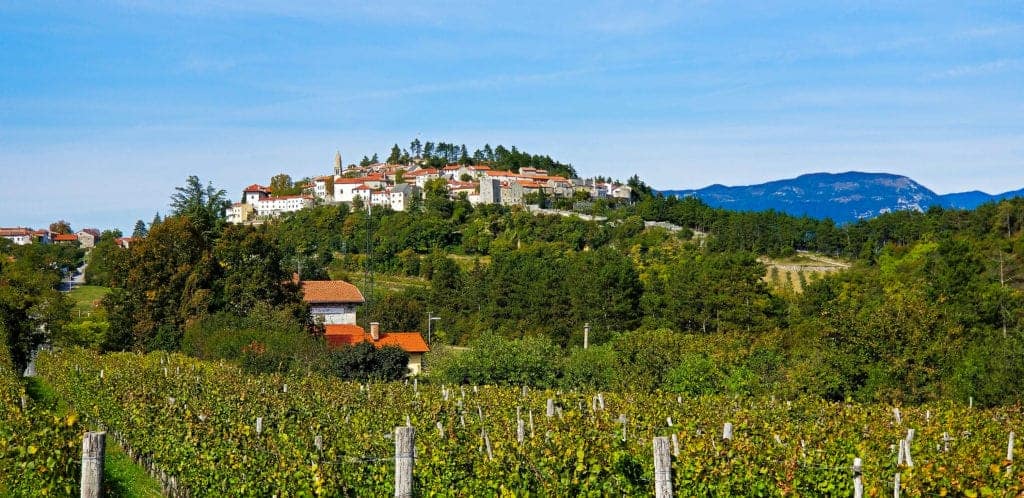
As I write this we are camped/parked next to a parking lot for a shopping mall, 1 ½ km from the old town centre of Koper and the Adriatic Sea. Mike and I walked in for our first evening and had a lovely dinner even if it wasn’t what we expected. We thought that we had ordered pasta, we actually got sliced steak and zucchini. Luckily it was very good. The town looks lovely. On a very short visit, the centre appears old and the shore area looks quite modern. The waterfront has interesting, modern street lights and nice wide walkways with lots of coffee shops and restaurants. We need to get back into this town in the daytime to see more of it. We have been here 4 days so far and haven’t yet got into the shopping mall. We have just been too busy. I expect that we will probably be here for about 10 days or so, although the norm with most campers is one to three days. We are using this spot as a base to tour both the Slovenian and Italian portions of the Istrian Peninsula. We did look into going into Italy to camp for a while, but their roads are really tiny. We are only 20 minutes from Trieste, so this location works fine as a base. We have put stickers on our RV for every country we have stayed in with the RV. Mike would have liked to have added Italy but that isn’t enough of a reason to chance their roads in this area.
Purely by luck, we have arrived near Trieste in time for their 10-day Barcolona festival and Regatta. I will post a separate article on our time in this portion of Italy.
OK, I am finally getting to the three major tourist attractions that we visited in the last week.
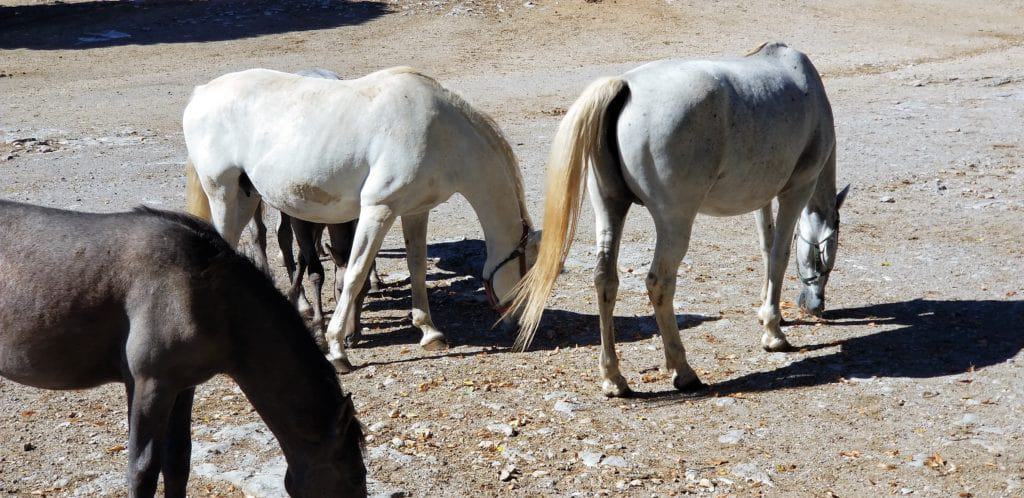
Lipica Stud Farm
The Lipica Stud Farm was the original stud farm of the Lipizzan breed which dates back to the 16th century and takes it name from the farm. Today Lipizzan Stallions are closely related with Vienna and its Spanish Riding School, but the Lipica Stud Farm still breeds and trains many Lipizzan stallions. The breed had been endangered numerous times and had to relocate because of warfare starting in the 1700s and continuing with World Wars I and II. I read that a Disney movie was made about the rescue of the Lipizzans during World War II by American troops. When I get home I will look for the movie Miracle of the White Stallions. After WWI the horses that had been moved or hidden where sent to various stud farms including Austria. It was at this time that the Lipica Stud Farm stopped providing the horses to Vienna and the Spanish Riding School.
We had a really nice tour guide showing us around the stud farm. I believe that she said there were 400 Lipizzan horses at the farm presently. Training is extremely intense and every few years the horses go through a series of tests to see whether or not they will be advanced to the next stage. This is a matter of both strength and intelligence. Today only stallions go through this training. They used to train mares, who are equally capable of the maneuvers, but they discovered that after a break for pregnancy, the mare forgot all that she had learned and had to start over at the beginning. It was decided that mares where worth more money breeding and the stallions would be the ones trained for the shows.
An interesting fact that we discovered is that Lipizzans are not really white horses they are officially gray horses. Like all gray horses, they are born dark and get lighter each year, much like old age causes our hair to turn white. 1% of Lipizzans stay dark. They have dark eyes, dark skin and only their hair turns white by the age of 10. True white horses are born with white hair and have pink skin which is much more sensitive to the sun. The Lipizzans live a long and active life, performing well into their 20s and living into their 30s.
The Slovenian word “lipa” derives from the “linden tree” which surround the Lipica Stud Farm. The staff plant a new linden tree for every foal born. Since 1966 the stud farm has been owned and operated by the Slovenian Government. Every day there is a small show put on that demonstrates the history of the horses and their training. It was very nice to see.
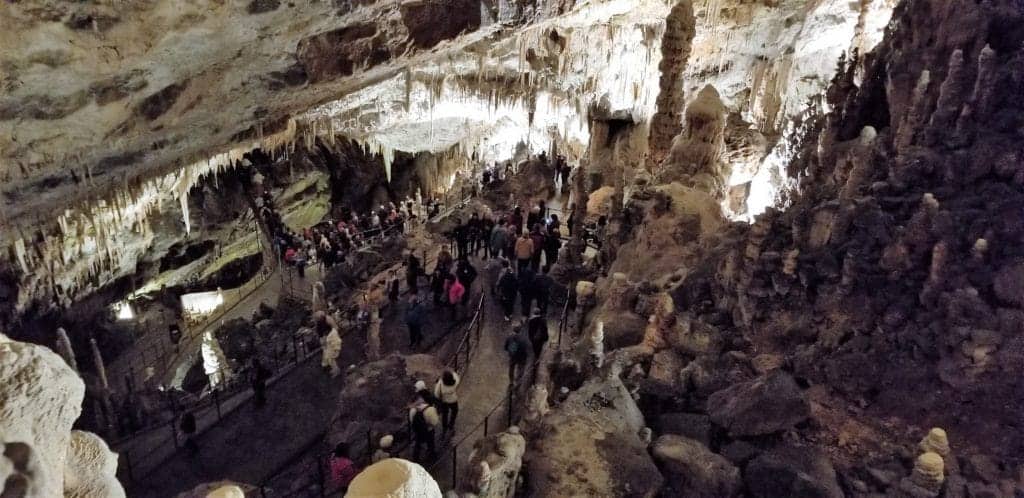
Postojna Cave
The caves are over 24 kilometers or 15 miles long and 2 million years old. In 1819, Archduke Ferdinand visited the caves and they then became officially known as a tourist destination. Electric lighting was added in 1884, preceding even Ljubljana. In 1872 they started the first cave train for tourists which was pushed by the tour guides in those days.
During World War II, German occupying forces used the cave to store aircraft fuel, which was destroyed by the Partisans. The fire burned for seven days, destroying a large section of the cave.
The caves, which have some of the largest caverns that we have ever seen in a cave, were really interesting. We were told that the stalactites and stalagmites grow about 1 cm every hundred years. You don’t want to break one of them off. One of the “rooms” is used as a concert hall at Christmas time. Apparently, animals, like lizards and bugs, that live in the dark caves, have a life expectancy two or three times longer than the same animals above ground. One reason given was that the constant temperature helps reduce the stress on the animals.
The caves have been visited by about 38 million people. I believe that. I counted about 120 people on our train. We were there on a Monday out of tourist season. One train is one tour group. The trains were just constant, they certainly keep the people moving through. We got to see about 5 kilometres of the cave which is more than you usually get to see. The train takes just over 10 minutes to cover about 3 km of the caves. You then get out and walk with 119 of your best friends and tour guide, for about two kilometres. It is actually better than that sounds. The tour guide was good and could be heard easily. At the end you get back on the train for your ride out. All told it is a 1 ½ hour tour. Mike and I were really impressed with how they showed off the caves. The lighting was excellent. Somehow, they managed to hide most of the actual light bulbs. In many caves, although they are well lit, the light bulbs themselves look out of place.

Predjama Castle
Predjama Castle was built directly into a 123 metre or 400-foot-high rocky cliff prior to 1274. It is the largest cave castle in the world (or so they say?). The picture at the top of this post shows Predjama Castle built into the cliff. It was built for safety and not comfort. Even with future renovations, safety stayed the main concern. In some of the rooms the cave or cliff actually forms some of the walls. According to the write-ups in the castle it was never a comfortable place to live but it was secure. It withstood a siege of over a year by the Holy Roman Empire. The castle owner would sneak out through the cave system in the back and go to local villages for food. After a year of this, a servant was bribed to tell the Romans when Erazem of Predjama was going to use the outhouse. The toilet was on a high floor on the outside face of the castle. Erazem goes to the toilet, the servant raises a flag and one single shot from a cannon blasted the baron off the toilet, killing him in the process. Tell me that Mike and I don’t get to places with interesting histories!

Leave a Reply